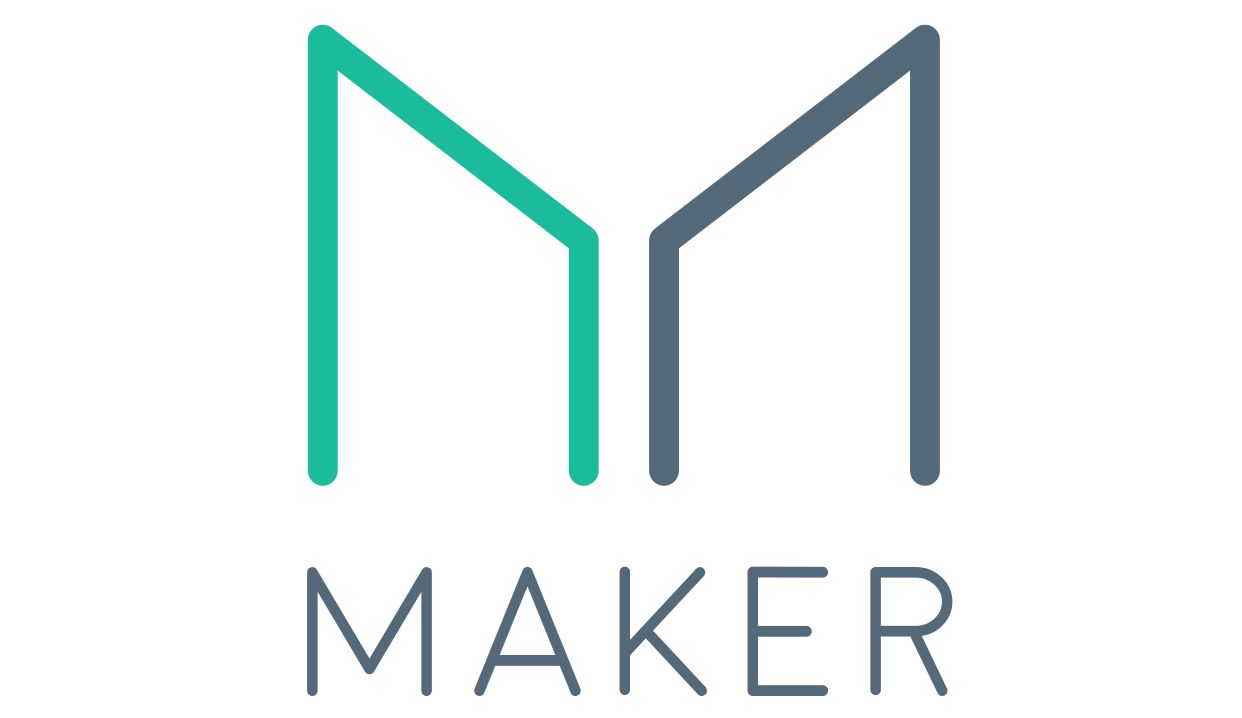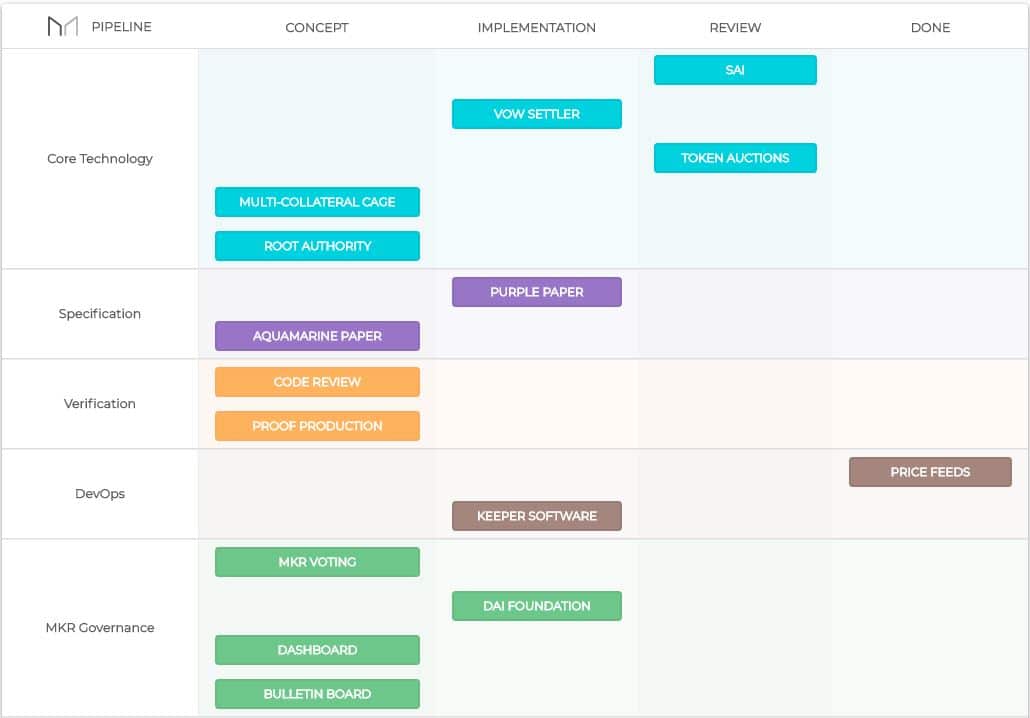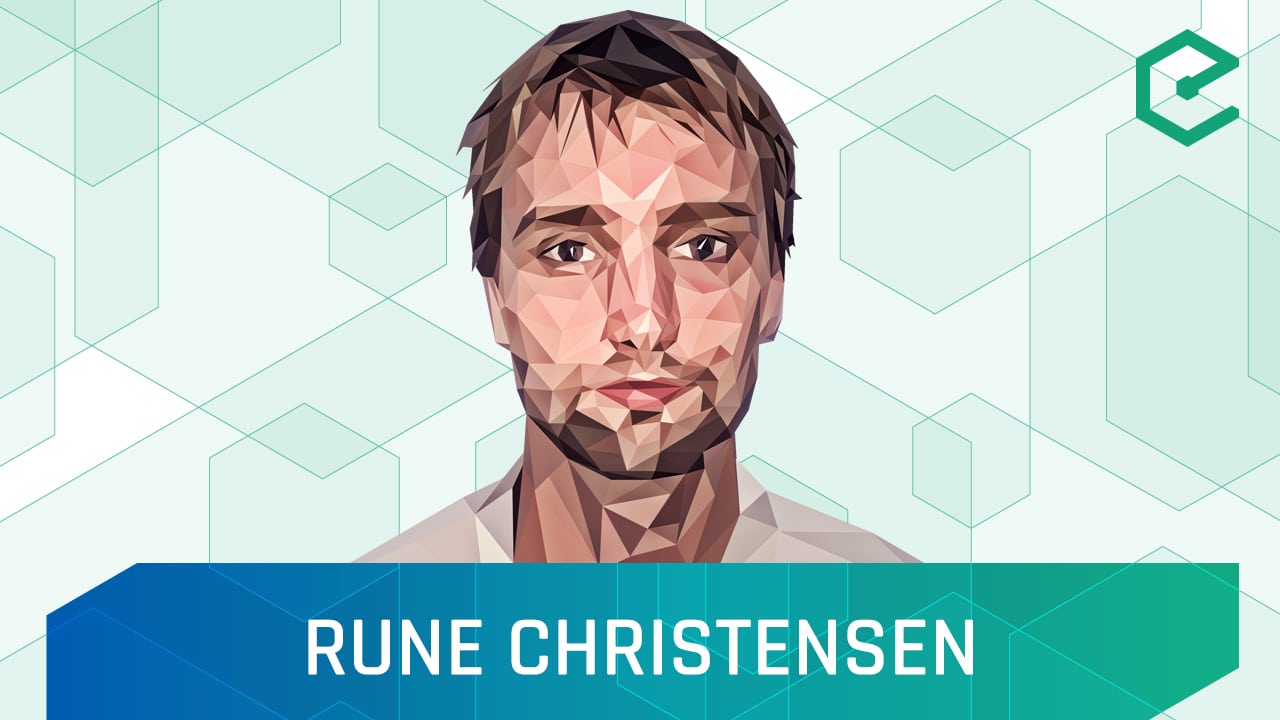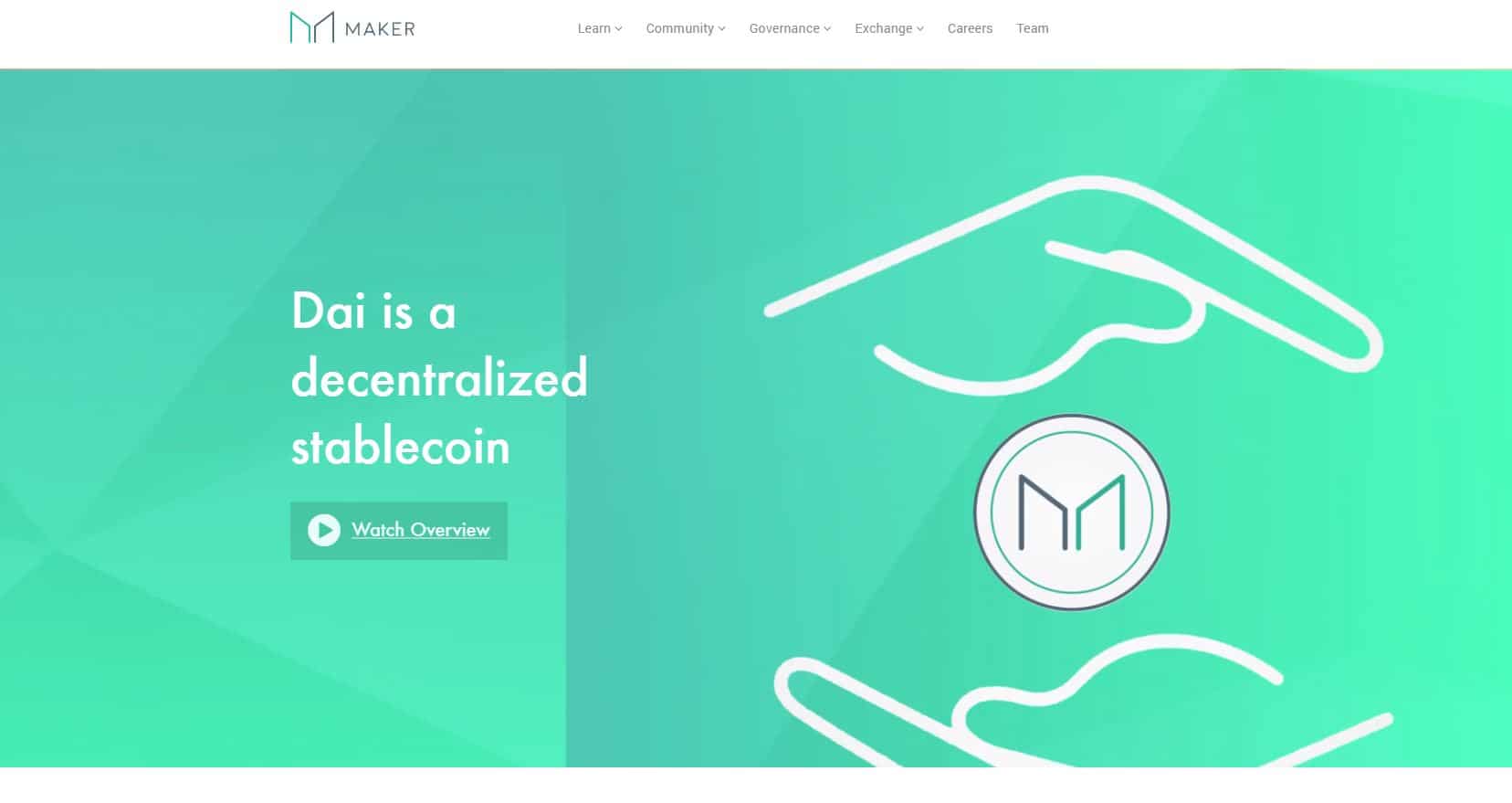What is Maker Dai?
Offering a viable stablecoin substitute to Tether, Maker is a smart contract platform that controls and sells Dai. Decentralized and trustless, the Maker platform stabilizes the value of Dai to one U.S. dollar using external market mechanisms and economic incentives.
Eliminating the necessity to trust a centralized organization and the hassle of third-party audits, Maker offers a transparent stablecoin system that is fully inspectable on the Ethereum blockchain.

Maker’s Dual Coin System
The Maker Platform has two coins: Makercoin (MKR) and Dai (DAI).
Makercoin – A token with a volatile price that is used to govern the Maker Platform
Dai – A price stable coin that is suitable for payments, savings, or collateral
Comparing Dai With Tether
Similarities
- Price – Both are soft-pegged to the price of one U.S. dollar
- Asset Type – Both are collateral-backed assets
- Mineability – Both coins are non-mineable
Differences
- Collateral Asset – Tether is backed by fiat U.S. dollars in audited bank reserves while Dai is backed by overcollateralized Ethereum smart contracts.
- Price Stabilization – Tether’s price is derived entirely from a holder’s ability to exchange one Tether for one U.S. dollar. Dai’s price is stabilized at one U.S. dollar using external market factors such as collateralized debt positions (CDPs), autonomous feedback mechanisms and external economic incentives.
- Blockchain – Tether is issued on the Bitcoin blockchain via the Omni Layer protocol while Dai is issued on the Ethereum blockchain.
- Decentralization – Tether is essentially centralized as it can only be created or destroyed by Tether Limited. On the other hand, Dai is more decentralized as Dai can only be created and destroyed by individual users.
Why Stablecoins Are Needed
Due to their immense volatility, normal cryptocurrencies are not ideal for any form of direct payment or use as collateral. To prevent huge fluctuations in value, stablecoins are needed to mitigate the market risk of mercurial crypto-assets.
Dai Stablecoin Uses
Maker covers four broad markets that could benefit from the use of Dai.
- Gambling Markets – Long-term bets are illogical to make with volatile cryptocurrencies. Volatile cryptocurrencies expose the gambler not only to the bet’s risk but also to the underlying asset price risk. Using a price stable cryptocurrency like Dai allows the gambler to isolate his risk solely to his or her gambling bet.
- Financial Markets – Price stable collateral such as Dai is needed for options and derivative smart contracts in the financial sector. Maker’s collateralized debt positions also offer permissionless decentralized trading leverage.
- International Trade – The cost of international transactions can be significant; Dai allows foreign exchange volatility to be adequately mitigated as well as eliminates middlemen from the transaction process.
- Transparent Accounting Systems – With completely verifiable transactions, Dai allows governments, corporations, and organizations to increase their efficiency and to lower their chance of corruption.
MKR Essential Functions
MKR has three essential roles on the Maker Platform:
1. Utility Token
You can only use MKR to pay the fees accrued on CDPs that generate Dai in the Maker system. When you pay fees, the MKR is “burned” or removed from the supply. MKR supply will decrease as MKR is burned. If demand for Dai and CDPs increases, the demand for MKR should also increase.
2. Governance Token
MKR holders use the token to vote for the risk management and logistics of the Maker system. Maker’s voting process is done through continuous approval voting.
Continuous approval voting – Every MKR holder can vote for any number of proposals with the MKR he or she holds. Any MKR holder can also submit a new proposal. Voters can withdraw or cast votes for any proposal at any time. The proposal that has the most votes from all MKR holders becomes the “top proposal” and can be activated to implement changes to the risk parameters of the system.
3. Recapitalization Resource
If parts of the collateral portfolio become under-collateralized, the Maker system automatically creates new MKR tokens and sells them on the market. This instantly raises money to capitalize the shortfall of value in the system and brings the entire Maker system back from insolvency. Bad governance will result in the value of all MKR tokens becoming diluted. This creates a penalty system that should align Maker voter’s interests with the interests of the entire Maker system.
[thrive_leads id=’5219′]
How the Maker System Works
For a user to interact with the Maker System, he or she must first create a collateralized debt position.
Collateralized Debt Positions
To create Dai on the Maker Platform, a user must leverage his or her Ethereum in Maker’s unique smart contracts known as Collateralized Debt Positions (CDPs). Although CDPs generate Dai for the user to use, they also accrue interest over time known as the “Stability Fee”.
Currently, Pooled Ether (PETH) is the only collateral type accepted on the Maker Platform. In order to obtain Dai from a CDP, a user must first convert his or her Ether to PETH.
User interaction with a CDP has four basic stages:
- Making the CDP. A user first sends a transaction to Maker to create a CDP. Then the user must send his or her PETH to collateralize the CDP.
- Generating Dai. The user then sends a transaction stating the amount of Dai they want from CDP. As the user receives Dai, an equivalent amount of debt in form of PETH is locked away in a smart contract. The user cannot access this locked away collateral until the outstanding Dai debt is paid off.
- Debt Reconciliation. To receive his or her collateral back, a user must pay off their outstanding debt in the CDP as well as pay a “Stability Fee” that essentially acts as interest on the outstanding debt. Stability Fees must be paid in MKR while outstanding debt can only be paid back in Dai.
- Withdrawing Collateral. After the user’s debt and stability fee are paid off, the user can finally retrieve his or her collateral back by sending a transaction to Maker.
Risk Parameters of CDPs
MKR holders vote on four key risk parameters for CDPs to ensure the stability of the Maker System:
- Debt Ceiling – Maximum amount of debt that can be created by a single type of CDP
- Liquidation Ratio – Collateral-to-debt ratio at which a CDP becomes vulnerable to liquidation
- Stability Fee – Additional fee calculated as an annual percentage yield on top of the CDP’s outlying debt
- Penalty Ratio – Ratio for the maximum amount of Dai that can be raised from a liquidation event
Price Stability Mechanisms
The Maker Stablecoin System uses external market factors and economic incentives to peg Dai to the value of a dollar.
Target Price
Dai’s Target Price has two primary functions on the Maker Platform:
- Calculate the collateral-to-debt ratio of a CDP
- Determine the value of collateral assets in a case of a global settlement
Target Rate Feedback Mechanism
In case of severe market instability, the Target Rate Feedback Mechanism (TRFM) can be automated. When turned on, the Dai Stablecoin System adjusts the Target Rate in order to stabilize Dai’s market price closer to the Target Price.
Engaging the TRFM breaks the fixed peg of Dai to the US dollar but changes the Target Rate to incentivize market participants to keep the price of Dai at the Target Price.
Market Price Falls Below Target Price
If the market price of Dai is below the Target Price, TFRM will increase the Target Rate.
An increase in Target Rate causes Dai generation to become more expensive. At the same time, an increased Target Rate causes the capital gains from holding Dai to increase. Increased capital gains will stimulate Dai’s aggregate demand.
An increase in Target Rate will reduce the supply of Dai while simultaneously increasing the demand for Dai. Basic economics should cause Dai’s market price to increase back towards the Target Price.
Market Price Climbs Above Target Price
If the market price of Dai is above the Target Price, TFRM will decrease the Target Rate.
A decrease in Target Rate causes Dai generation to become less expensive. At the same time, a decreased Target Rate will lower capital gains associated with holding Dai. Decreased capital gains will decrease Dai’s aggregate demand.
A decrease in Target Rate will increase the supply of Dai while simultaneously decreasing the demand for Dai. Basic economics should cause Dai’s market price to decrease back towards the Target Price.
Sensitivity Parameter
The stablecoin system’s sensitivity parameter determines the magnitude of Target Rate in response to any change in the market price of Dai.
Anytime the Sensitivity Parameter and the Target Rate are both equal to zero, Dai will be pegged to current Target Price.
Global Settlement
A decentralized last choice option, global settlement guarantees Dai holders receive the Target Price in case of dire emergency. Global settlement slowly shutdowns the entire Maker system and ensures all users receive the net value of assets they are entitled to.
For a global settlement to occur, MKR voters must vote on the situation to ensure a system shutdown is truly necessary. Some cases that may merit a global settlement include long-term market irrationality, a security breach, or system upgrades.
Maker Platform’s Risk Factors
No system is perfect. Maker outlines its biggest risk factors in the implementation of its platform. It also lists its actions to mitigate these risk factors.
- Malicious hacking attack – If deployed smart contracts have any vulnerability, a malicious coder could attempt to steal collateral from the Maker Platform.
- Black Swan event – If Ethereum has a violent, unexpected crash, the Maker system may be unable to maintain the price control of system assets.
- Competition – Completely decentralized, the Dai Stabalecoin System is extremely complex. Maker fears that the market may decide to go with a simpler, centralized digital asset.
- Irrational Markets – Irrational market actions over a large enough period of time could cause Maker users to lose confidence in the stability and liquidity of the system.
- Maker Team Failure – The Maker management team fully recognizes adverse ramifications could result from human error or failing to prepare for all circumstances.
Fundraising and Trading
As Dai is soft-pegged to the price of one U.S. dollar, it’s not meant for trading. To generate Dai, download an Ethereum browser such as MetaMask and surf over to the Dai platform.
MKR was initially sold in a public forum and had multiple private offerings before moving over to Openledger. Currently, MKR and Dai are sold through the Oasis Decentralized Exchange (OasisDex).
To connect to OasisDex, open an Ethereum browser and navigate to OasisDex.
MKR currently has a circulating supply of 618,228 out of a total supply of 1,000,000.
How to Store Makercoin and Dai
Both Maker and Dai are standard Ethereum Tokens adhering to the ERC-20 standard. Therefore, Maker and Dai must be stored in an ERC-20 compliant wallet such as MyEtherWallet.
Offering better security than software wallets, hardware wallets such as the Ledger Nano S and Trezor are generally the safest way to store ERC-20 standard tokens.
Product Development
The first fully decentralized stablecoin on Ethereum, Dai officially went live on December 18th, 2017.
In the next six to twelve months, the Maker Platforms plans to expand the number of collateral types that can be used to generate Dai. At this moment, only Pooled Ethereum can be used to create CDPs and make Dai.
Maker’s development roadmap is quite aggressive and focused on the widespread adoption of Dai over time in multiple blockchain applications.

Maker Team
Founded almost three years ago, MakerDao has quickly grown from a tiny team to over thirty-five team members. MakerDao is lead by Rune Christensen, its CEO and founder.

Conclusion
With the veracity of Tether’s dollar reserves in question, Maker’s Dai provides a viable stablecoin substitute. Maker has created fully inspectable and transparent stablecoin system that is truly decentralized and trustless. The entire blockchain ecosystem should benefit from the launch of Dai.
For additional information, check out MakerDao’s website and its whitepaper.






